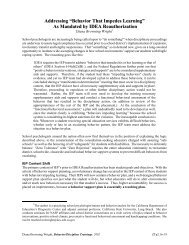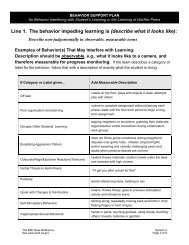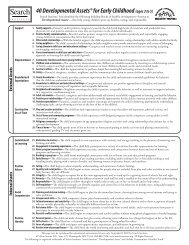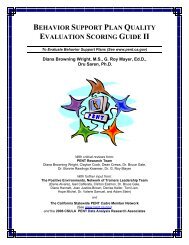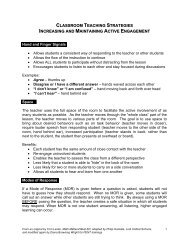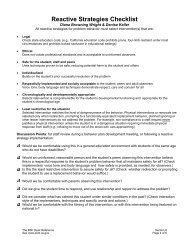Mental Health Models - PENT
Mental Health Models - PENT
Mental Health Models - PENT
Create successful ePaper yourself
Turn your PDF publications into a flip-book with our unique Google optimized e-Paper software.
<strong>Mental</strong> <strong>Health</strong> <strong>Models</strong><br />
Selected Documents and Information<br />
from the CDE Website<br />
www.cde.ca.gov/sp/se/ac/<br />
Compiled by:<br />
Valerie J. Samuel, Ph.D.<br />
<strong>PENT</strong> Leader
Transitioning from AB3232 to AB114<br />
<strong>Mental</strong> <strong>Health</strong> <strong>Models</strong><br />
Compiled by Valerie J. Samuel, Ph.D., <strong>PENT</strong> Leader<br />
This section contains several m ental healt h models t hat exist given the transition of<br />
services from County <strong>Mental</strong> <strong>Health</strong> (C MH) to the schools. Desert/ Mountain SELPA<br />
and San Diego are well-establis hed programs that have been in existenc e for years.<br />
Santa Barbara County SELPA and North Re gional SELPA (Alameda County) programs<br />
are in the initial stages of development. In addition, there are two other documents.<br />
One provides information on Wraparound Serv ices and one on Promising/Replic able<br />
Practices. These resources can provide <strong>PENT</strong> Cadre members with information to<br />
support your school district or SELPA in the development of a new mental health model.<br />
Further information is also located on the CDE website: www.cde.ca.gov/sp/se/ac/.<br />
<strong>PENT</strong> Forum 2012<br />
www.pent.ca.gov<br />
<strong>Mental</strong> <strong>Health</strong> Changes<br />
Page 13
<strong>Mental</strong> <strong>Health</strong> <strong>Models</strong><br />
Desert/Mountain SELPA<br />
Compiled by Valerie J. Samuel, Ph.D., <strong>PENT</strong> Leader<br />
Contacts<br />
Jenae Tucker, Director<br />
Cheryl Goldberg-Diaz, Program Manager<br />
Desert/Mountain SELPA<br />
Desert/Mountain SELPA Children’s Center<br />
17800 Highway 18<br />
Apple Valley, CA 92307<br />
Phone: 760-242-6336<br />
Fax: 760-946-0819<br />
Website http://dmselpa.sbcss.k12.ca.us/dmscc<br />
The model has been in existence since 2003 and is a collabor ative one with San<br />
Bernardino County Behavioral <strong>Health</strong> and SELPA’s. It grew from 2 therapists to a<br />
comprehensive mental health ce nter that focuses on childr en. The Childr en’s Center<br />
focuses on both Special Ed eligible students and all Medical eligib le students who need<br />
services.<br />
Overview<br />
• Superintendents agreed state funds will stay at the SELPA Level<br />
• All SELPA’s participate except West End SELPA.<br />
• Desert/Mountain SELPA Children’s Center provides the mental health services<br />
for over 200 students in 15 districts as well as in 11 charter school campuses in<br />
San Diego<br />
Services<br />
• Individual, group, family<br />
• Community Outreach Program<br />
• SART - Screening, Assessment, Referral and Treatment - (Clients 0-5 years of age)<br />
• Residential Assessment & Monitoring of SELPA students<br />
• School based services for neighboring SELPA’s<br />
<strong>PENT</strong> Forum 2012<br />
www.pent.ca.gov<br />
<strong>Mental</strong> <strong>Health</strong> Changes<br />
Page 14
Unique Components<br />
Desert/Mountain SELPA Children ’s Center applied to be a pr ovider through the Early<br />
and Periodic Screening, Diagnosis, and Treatment (EPSDT) program.<br />
• This allows them to bill Medi-Cal for the services they provide to students.<br />
• It also allows them to hire mental health workers without requirements of both a<br />
professional license and PPL.<br />
• Districts pay a fee for service for their Special Ed students. However, there is no<br />
fee for their Medi-Cal eligible students.<br />
• Memo of Understanding(MOU)with Behavioral <strong>Health</strong> to handle severe mental<br />
health cases<br />
• Children’s Center has contracted with SELPA’s to provide assessments and<br />
monitoring of residential placements.<br />
• SELPA’s are responsible for Residential placement costs<br />
Any distric t, SELPA or agency that would lik e further information please contact<br />
Desert/Mountain SELPA Children’s Center.<br />
<strong>PENT</strong> Forum 2012<br />
www.pent.ca.gov<br />
<strong>Mental</strong> <strong>Health</strong> Changes<br />
Page 15
<strong>PENT</strong> Forum 2012<br />
www.pent.ca.gov<br />
Psychotherapy and residential<br />
placement as related services<br />
Desert/Mountain SELPA<br />
• Consortium of 15 school districts and 11<br />
independent LEA charter schools<br />
• 99,400 enrollment<br />
• 10,649 students with disabilities (10.7%)<br />
<strong>Mental</strong> <strong>Health</strong> Changes<br />
Page 16
<strong>PENT</strong> Forum 2012<br />
www.pent.ca.gov<br />
<strong>Mental</strong> <strong>Health</strong> Services<br />
• SELPA Staff<br />
– MSW/MFT with PPS credentials<br />
– Fee for Service funded<br />
• NPA Staff<br />
– LCSW/MFT and MSW/MFT interns<br />
– No requirement for PPS credential<br />
– SELPA provided clinical supervision<br />
<strong>Mental</strong> <strong>Health</strong> Services<br />
• DBH Partnership<br />
– Early, Periodic, Screening, Diagnosis, and<br />
Treatment (EPSDT) RFP<br />
– Access to full-scope MediCal funding<br />
<strong>Mental</strong> <strong>Health</strong> Changes<br />
Page 17
<strong>PENT</strong> Forum 2012<br />
www.pent.ca.gov<br />
EPSDT Medi-Cal Funding<br />
$2.61 @ minute: $156.6 @ hour<br />
<strong>Mental</strong> <strong>Health</strong> Services<br />
• Desert/Mountain SELPA Children’s<br />
Center<br />
– School-based EPSDT services<br />
– All MediCal eligible children<br />
• Contracted DBH Clinic<br />
– LCSW/MFT and MSW/MFT Interns without<br />
the necessity to concurrently hold a PPS<br />
credential<br />
– Local, County, and State MediCal audits<br />
<strong>Mental</strong> <strong>Health</strong> Changes<br />
Page 18
<strong>PENT</strong> Forum 2012<br />
www.pent.ca.gov<br />
<strong>Mental</strong> <strong>Health</strong> Services<br />
• $10 million budget<br />
• >80 therapists<br />
• >3000 children 0-21 served annually<br />
• About 680 children with disabilities<br />
• In >200 schools in all 15 districts as well<br />
as our 11 charter school campuses in San<br />
Diego County.<br />
What has Changed?<br />
• Non-MediCal eligible receive services at no<br />
cost to school districts.<br />
• Residential placement is now paid for by<br />
the SELPA<br />
• Residential assessment<br />
• Residential monitoring<br />
• Provide school-based mental health<br />
services for neighboring SELPAs<br />
<strong>Mental</strong> <strong>Health</strong> Changes<br />
Page 19
<strong>PENT</strong> Forum 2012<br />
www.pent.ca.gov<br />
Where do we go from here?<br />
• Keys to successful mental health<br />
treatment:<br />
– Early identification and treatment,<br />
– Comprehensive system of supports,<br />
– Family training and supports,<br />
<strong>Mental</strong> <strong>Health</strong> Changes<br />
Page 20
<strong>Mental</strong> <strong>Health</strong> <strong>Models</strong><br />
San Diego Unified School District<br />
Compiled by Valerie J. Samuel, Ph.D., <strong>PENT</strong> Leader<br />
Contacts<br />
Susan Martinez, Executive Director<br />
Shirley Culver, Program Manager<br />
<strong>Mental</strong> <strong>Health</strong> Resource Center (MHRC)<br />
2351 Cardinal Lane, Annex B<br />
San Diego, CA 92123<br />
(858) 573-2227 - Phone<br />
(858) 496-2113 - Fax<br />
The model has been in existence since 2001 and is a collaborative one with San<br />
County <strong>Mental</strong> <strong>Health</strong>. A grant allowed for the dev elopment of the <strong>Mental</strong> Healt h<br />
Resource Center (MHRC). It i s a school di strict coordinated m ental hea lth service<br />
model.<br />
Overview<br />
• District enrollment is 120,000 students<br />
• MHRC is part of the Student Services Department of SDUSD.<br />
• MHRC uses the Least Restrictive Environment model for both education and<br />
mental health needs of student.<br />
• MHRC collaborates with County <strong>Mental</strong> <strong>Health</strong>, and has become a contract<br />
provider for CMH submitting requests for proposals. As such, MHRC is a Medi-<br />
Cal facility through the County of San Diego and is partially funded through the<br />
Safe Schools/<strong>Health</strong>y Students grant with the Departments of Education,<br />
Juvenile Justice, and Children's <strong>Mental</strong> <strong>Health</strong> Services.<br />
• Selected outside agencies provide contracted services to deliver mental health<br />
services to those students and their families who need specialized care.<br />
Services<br />
<strong>Mental</strong> <strong>Health</strong> Intervention Teams – T hese mental health st aff work with schools,<br />
teachers and staff. The focus is on classr oom wide strategies, teaching Positive<br />
Behavioral Supports, and improving staff skills.<br />
<strong>PENT</strong> Forum 2012<br />
www.pent.ca.gov<br />
<strong>Mental</strong> <strong>Health</strong> Changes<br />
Page 21
Outpatient Services – These services are for students who are likely to improve if<br />
given individual therapy. Students can be sent to a clinic for individual therapy or to<br />
an Enhanced Classroom (K-8).<br />
Enhanced Classroom (K-8) is a special site program that provi des an integrated<br />
approach t o treatment. Embedded within t he school’s educational program are<br />
therapeutic services. These incl ude mental health clinicians, rehabilitation specialist,<br />
and access to psychiatrist.<br />
Day Treatment Services – At elementary, middle school and high school levels there<br />
are designated facilities designed to provide a more intensive therapeutic experience .<br />
<strong>Mental</strong> health clinicians, rehabilitation s pecialist, and access to psychiatrist are key<br />
components to program. Students are provided individual, group, family therapy.<br />
<strong>Mental</strong> health is integrated to provide better services t hat help student benefit from<br />
their educ ation. Goal is to support student in being able to ret urn to a more least<br />
restrictive learning environment.<br />
Unique Components<br />
MHRC is a Medi- Cal provider and contract provider through mental health.<br />
• This allows them to bill Medi-Cal for the services they provide to students.<br />
• It allows them to hire mental health workers from CMH who provide<br />
assessment, treatment, and case management for targeted schools.<br />
• MHRC use day treatment verses residential. This significantly reduces number<br />
of students having to go to residential placement and saves about $100,000<br />
per student.<br />
• Day Treatment costs are virtually offset by reimbursement from Medi-Cal.<br />
• Day treatment can offset costs of paraprofessionals in program.<br />
• Focus is on integrated services within school setting as opposed to wrap<br />
around which focuses on home and community setting.<br />
<strong>PENT</strong> Forum 2012<br />
www.pent.ca.gov<br />
<strong>Mental</strong> <strong>Health</strong> Changes<br />
Page 22
<strong>PENT</strong> Forum 2012<br />
www.pent.ca.gov<br />
SAN DIEGO UNIFIED SCHOOL DISTRICT<br />
SPECIAL EDUCATION PROGRAM<br />
Susan Martinez, Executive Director<br />
MENTAL HEALTH RESOURCE CENTER<br />
Shirley Culver, LCSW, Program Manager<br />
Started with SS/HS grant in 2001<br />
Focus:<br />
◦ General education students at high risk – who<br />
were expelled<br />
◦ Early intervention with high risk students in<br />
middle school<br />
◦ Prevention with preschoolers<br />
Developed partnerships:<br />
County<strong>Mental</strong> <strong>Health</strong> in 2002<br />
Special Ed in 2002,<br />
County Probation in 2005<br />
County Child Welfare in 2006<br />
<strong>Mental</strong> <strong>Health</strong> Changes<br />
Page 23
<strong>PENT</strong> Forum 2012<br />
www.pent.ca.gov<br />
Establish and sustain mental health center<br />
Develop partnerships with various<br />
collaborators to insure sustainability and to<br />
maximize impact of services<br />
Strategically infuse school system with<br />
trained, expert mental health staff to:<br />
◦ Change outcomes for sub-populations<br />
of students<br />
◦ Provide supports to education staff<br />
<strong>Mental</strong> <strong>Health</strong> Changes<br />
Page 24
<strong>PENT</strong> Forum 2012<br />
www.pent.ca.gov<br />
Early intervention for Special Education students<br />
◦ District <strong>Mental</strong> <strong>Health</strong> Intervention Team - $1.3<br />
million (pre2726 dollars)<br />
◦ District funded Day Treatment - $900,000<br />
Intensive Treatment for high need students<br />
◦ CMH Contract for Day Treatment - $2.9 million<br />
(expanding to $3.4 million)<br />
◦ CMH Contract for Outpatient - $950,000<br />
High School Day Treatment – Capacity – 105<br />
75 slots paid from contract – put all Medi-Cal (MC)<br />
eligible students in these slots<br />
Middle School Day Treatment – Capacity – 42<br />
30 slots paid from contract – put all Medi-Cal eligible<br />
students in these slots<br />
Child Day (K-5) Treatment – Capacity - 24<br />
In process of negotiating for 12 slots with CMH for MC<br />
eligible students.<br />
TOTAL – 171 District Enrollment – 120,000<br />
<strong>Mental</strong> <strong>Health</strong> Changes<br />
Page 25
<strong>PENT</strong> Forum 2012<br />
www.pent.ca.gov<br />
Lead Licensed <strong>Mental</strong> <strong>Health</strong> Professional –<br />
supervisor<br />
<strong>Mental</strong> <strong>Health</strong> Clinicians (licensed and unlicensed) –<br />
one for every 10-12 students<br />
Rehabilitation Specialists (experienced<br />
paraprofessionals) – two for every classroom – one<br />
funded through day treatment, one through school<br />
budget.<br />
Psychiatry time – 6-8 hours per week<br />
Clerical support – 1.0 FTE<br />
100% Revenue Offset through MC for eligible<br />
students<br />
Annual non-educational cost of a day treatment<br />
slot approximately $27,000 vs. $140,000 for noneducational<br />
cost of residential<br />
152 day treatment students last year vs. 54<br />
residential students<br />
Day treatment offsets 40-50% of the costs of<br />
paraprofessionals<br />
Provides most frequent mental health interventions<br />
with the least documentation in integrated<br />
classroom. Providing: mental health groups,<br />
individual treatment and family treatment.<br />
<strong>Mental</strong> <strong>Health</strong> Changes<br />
Page 26
<strong>PENT</strong> Forum 2012<br />
www.pent.ca.gov<br />
Enhanced Classrooms K-8 –Capacity 40<br />
◦ 1 <strong>Mental</strong> <strong>Health</strong> Clinician for 10 students<br />
◦ 2 Rehabilitation Specialists for each classroom<br />
◦ Psychiatry time<br />
◦ Lead Licensed <strong>Mental</strong> <strong>Health</strong> Clinician<br />
Integrated education and treatment.<br />
Intensive outpatient treatment<br />
Two of four clinicians funded through<br />
outpatient Medi-Cal contract.<br />
Individual Therapy – Capacity – 90-100<br />
▸ 6 <strong>Mental</strong> <strong>Health</strong> Clinicians<br />
▸ See students at school, home visits periodically<br />
▸ Consult with teachers, other school staff<br />
▸ Contract with CMH – MC pays for all eligible MC<br />
students<br />
▸ Prioritize students who would not get to a<br />
clinic or would not be successful without<br />
educational integration.<br />
<strong>Mental</strong> <strong>Health</strong> Changes<br />
Page 27
<strong>PENT</strong> Forum 2012<br />
www.pent.ca.gov<br />
<strong>Mental</strong> <strong>Health</strong> Intervention Teams<br />
Teams of LMHC and Rehabilitation Specialists , who support a<br />
cluster of schools – previously only elementary and middle<br />
school<br />
▸ Work in classrooms with teachers and aides to increase<br />
structure, positive reinforcement and behavioral<br />
management skills.<br />
▸ Work with students in the classroom and in group therapy<br />
▸ Work with parents of children with special needs to provide<br />
specialized skills<br />
▸ Work with school psychologists and IEP teams to meet the<br />
individualized needs of children in the least restrictive<br />
level of care.<br />
Develop an array services with fullscope Medi-Cal and LEA<br />
Medi-Cal<br />
◦ MHIT uses LEA MC<br />
◦ Individual Therapy uses fullscope MC<br />
◦ Enhanced Classrooms use fullscope MC<br />
▸ Minimize documentation requirements depending on funding.<br />
Clinician who knows the student does the assessment to<br />
minimize time and cost<br />
Move treatment as close to the primary educational setting as<br />
possible. Focus treatment focus on IEP goals to improve<br />
ability to benefit from education<br />
<strong>Mental</strong> <strong>Health</strong> Changes<br />
Page 28
<strong>PENT</strong> Forum 2012<br />
www.pent.ca.gov<br />
Expanding MHIT from 50 schools to 200<br />
Having MHIT Clinicians become the assessors<br />
Having MHIT teams provide most outpatient type<br />
treatment needed on site<br />
Individual Therapy team providing supports for<br />
students who primarily need individual.<br />
Re-emphasizing assessment to focus on need for<br />
services “to benefit from their education.”<br />
Referring all other treatment needs of students to<br />
community mental health clinics or parent health<br />
insurer<br />
Create Interdisciplinary Team (ID) to review all<br />
recommendations for more restrictive level of care.<br />
Includes representatives from: Psychologists,<br />
Behavioral Specialist Unit, Day Treatment staff and<br />
MH Administration<br />
ID Team will explore available resources to support<br />
student at their school site.<br />
Day Treatment assessor will work with site<br />
assessor<br />
Attempt to support students in day treatment prior<br />
to residential<br />
Educate site staff to know which students really<br />
need day treatment<br />
<strong>Mental</strong> <strong>Health</strong> Changes<br />
Page 29
<strong>PENT</strong> Forum 2012<br />
www.pent.ca.gov<br />
Develop support programs at secondary schools to:<br />
Transition students returning or at-risk of more restrictive<br />
placements.<br />
◦ Physical space where students come 1-3 periods a day for<br />
supported class instruction. Staffing includes teacher and<br />
rehabilitation specialist<br />
◦ LMHC and Rehab staff available at all times for students who<br />
need interventions due to crises, planned interventions or having a<br />
difficult day.<br />
Prevention & Treatment for general education students<br />
with medically necessary conditions and sub<br />
populations. Contracts with CMH<br />
◦ Preschool - $600,000<br />
◦ Probation students - $660,000<br />
◦ Suicide Prevention - $750,000<br />
Provides mental health staff to support general<br />
educators and to develop proactive interventions.<br />
<strong>Mental</strong> <strong>Health</strong> Changes<br />
Page 30
<strong>PENT</strong> Forum 2012<br />
www.pent.ca.gov<br />
1<br />
2<br />
MENTAL HEALTH IEP<br />
SERVICES TRANSITION<br />
Santa Barbara County SELPA<br />
November 16, 2011<br />
By Jarice Butterfield, Ph.D.<br />
SBCSELPA Director<br />
About SBCSELPA<br />
Approximate SPED Pupil Count of 8,000 students<br />
22 LEAs spread over a large geographical area ranging<br />
from Carpinteria to Cuyuma<br />
Vast diversity between LEAs (100 ADA to 16,000 ADA;<br />
basic aid and non basic aid; urban and rural)<br />
No NPS’ (residential or non residential) in SB County<br />
LEA frustration over CMH declining to provide IEP MH<br />
services and lack of decision making regarding NPS IEP<br />
placements<br />
1.4 million loss of IDEA MH funding in 2011-2012 due to<br />
Casemis errors & low rate of students identified for MH svc.<br />
<strong>Mental</strong> <strong>Health</strong> Changes<br />
Page 31
<strong>PENT</strong> Forum 2012<br />
www.pent.ca.gov<br />
3<br />
4<br />
<strong>Mental</strong> <strong>Health</strong> Funding<br />
Background Information<br />
AB3632 legislation related to IEP MH services was<br />
repealed and became inoperative July 1, 2011<br />
The mandate to provide IEP mental health services<br />
became the responsibility of SELPAs/LEAs versus county<br />
department of mental health<br />
State and IDEA federal mental health funding began<br />
flowing to SELPAs<br />
SBCSELPA formed an Ad Hoc <strong>Mental</strong> <strong>Health</strong> Committee<br />
to advise and consult with SELPA Director on how to<br />
provide IEP mental health related services to students;<br />
SELPA Director made recommendations to JPA Board<br />
Education Taking Back<br />
Coordination of IEP Related <strong>Mental</strong><br />
<strong>Health</strong> Services- It Can be Done!<br />
<strong>Mental</strong> <strong>Health</strong> Changes<br />
Page 32
<strong>PENT</strong> Forum 2012<br />
www.pent.ca.gov<br />
5<br />
6<br />
Recommendations Made to<br />
SBCSELPA JPA Board<br />
Equivalent funding to the prior year’s<br />
“Pre Referral” mental health funding to flow directly to<br />
LEAs to continue pre referral MH services<br />
SELPA engage in a 6 month MOU with Department of<br />
County <strong>Mental</strong> <strong>Health</strong> (CMH) for only provision of IEP<br />
mental health related services and funding of mental<br />
services for students placed in residential non public<br />
schools (funded out of Prop 63 one time funding)<br />
SELPA hire a Clinical <strong>Mental</strong> <strong>Health</strong> Specialist by 9-1-<br />
11<br />
Hiring a SELPA<br />
Clinical <strong>Mental</strong> <strong>Health</strong> Specialist<br />
Qualifications: Licensed MFT, LCSW or Clinical<br />
Psychologist (combined with PPS preferred)<br />
Oversee mental health services referral process<br />
Solicit mental health service providers/vendors<br />
Network with mental health vendors<br />
Track and monitor students receiving IEP mental health<br />
services – ensure Casemis accuracy<br />
Provide consultation and support to LEA staff and parents<br />
Assist LEAs in assessment of need for NPS placements<br />
Oversee students placed in NPS (seek placements,<br />
monitor progress, make site visits, and engage in<br />
transition planning)<br />
<strong>Mental</strong> <strong>Health</strong> Changes<br />
Page 33
<strong>PENT</strong> Forum 2012<br />
www.pent.ca.gov<br />
7<br />
8<br />
Process for Providing IEP Related<br />
<strong>Mental</strong> <strong>Health</strong> Services<br />
Role of LEAs:<br />
• Psychologist Assessment of need for mental health related<br />
services<br />
• Make referrals to SELPA Clinical <strong>Mental</strong> <strong>Health</strong> Specialist<br />
Role of SELPA:<br />
• Process referrals for mental health services<br />
• Send referrals for IEP related services County <strong>Mental</strong> <strong>Health</strong><br />
(CMH) or other MH NPA vendors when declined by CMH<br />
• Selpa Clinician participation in assessment with LEA<br />
psychologist to determine need for residential NPS placements<br />
• Coordinate and oversee student NPS residential placements<br />
• Provide mental health service training to LEA staff<br />
• Fund all mental health services not covered by Prop 63 funding<br />
through ADMHS (out of IDEA and State mental health funding)<br />
Process for Providing IEP Related<br />
<strong>Mental</strong> <strong>Health</strong> Services Cont’d.<br />
Role of County <strong>Mental</strong> <strong>Health</strong> (ADMHS)<br />
• Determine if referrals for MH related services are<br />
within “scope of practice” – deny or accept<br />
• Provide collateral, case management, individual<br />
therapy ( emotional or behavioral) and medication<br />
management services<br />
• Provide support to Centers for Therapeutic Education<br />
(CTE) ED programs (individual, group, and family)<br />
(Note: CMH engages in sub-contracts with outside vendors)<br />
Role of Other Vendors:<br />
• Determine if referrals for MH related services are<br />
within “scope of practice” – deny or accept<br />
<strong>Mental</strong> <strong>Health</strong> Changes<br />
Page 34
<strong>PENT</strong> Forum 2012<br />
www.pent.ca.gov<br />
9<br />
10<br />
Barriers to Implementing<br />
Change<br />
Paradigm shift for CMH and LEA Staff<br />
• Educational model versus medical model for providing<br />
MH IEP related services and NPS placements<br />
• CMH accepting and understanding new role<br />
• Fear of change; negative community perception<br />
• Lack of time to develop process & training<br />
Financial:<br />
• Uncertainty regarding cost of services versus funding<br />
due to lack of accurate student data<br />
• LEA needs vary<br />
• Ensure all LEAs receive their proportionate share of<br />
funding and services in an “off-the-top” funding model<br />
Transition Plan 2-16-11 when<br />
County <strong>Mental</strong> <strong>Health</strong> MOU Ends<br />
SELPA to solicit contracts with various mental health<br />
providers and/or CMH to provide IEP related mental<br />
health services on behalf of 22 LEAs in SELPA<br />
beginning 12-1-11<br />
All providers except CMH are requested to have NPA<br />
certification through the CDE<br />
SELPA will contract with any agency that does not<br />
provide “direct agency services (no sub-contracting)<br />
SELPA to begin funding 100% of all costs of IEP related<br />
MH services for 22 LEAs to include NPS costs<br />
(education, MH, and residential) 2-16-11<br />
<strong>Mental</strong> <strong>Health</strong> Changes<br />
Page 35
<strong>PENT</strong> Forum 2012<br />
www.pent.ca.gov<br />
11<br />
12<br />
Transition Plan Cont’d<br />
SELPA will no longer be funding indirect services<br />
services with CMH such as “collateral”, “case<br />
management”, etc.<br />
<strong>Mental</strong> health NPA vendors must submit<br />
proposals to SELPA that indicate the following:<br />
scope of services they can provide (individual therapy, group<br />
therapy, social working, family counseling, behavioral support, etc.<br />
hourly rate for IEP related services ( hourly rate must include any<br />
indirect services such as phone calls, contact with LEA staff, etc.)<br />
Hourly rate for attendance at IEPs<br />
Projected Cost Savings<br />
Estimated savings of over $1,000,000 per<br />
year by going to a SELPA coordinated<br />
mental health service model versus a<br />
County <strong>Mental</strong> <strong>Health</strong> (CMH) coordinated<br />
mental health service model !<br />
<strong>Mental</strong> <strong>Health</strong> Changes<br />
Page 36
<strong>PENT</strong> Forum 2012<br />
www.pent.ca.gov<br />
13<br />
14<br />
Future Plan for Providing IEP<br />
<strong>Mental</strong> <strong>Health</strong> Services Through<br />
Implementation of SELPA Coordinated Model<br />
Be able to provide a broader array of mental health<br />
services to students who need mental health related<br />
services to include behavioral support, social work<br />
with families, and research based therapies specific to<br />
student’s area of need (CBT, DBT, etc.)<br />
Be able to provide a continuum of intensive services to<br />
students who are ED to prevent need for out-of-home<br />
restrictive NPS placements and to students returning from<br />
NPS placement to ensure successful transition<br />
Provide research-based training to school-based mental<br />
health personnel – potentially hire additional school-based<br />
personnel<br />
For More Information….<br />
Go to SBCSELPA.org – look under “Publications”<br />
Email Jarice Butterfield at jariceb@sbceo.org<br />
or Claudia Echavarria at cechavarria@sbceo.org<br />
Call SBCSELPA 805-683-1424<br />
<strong>Mental</strong> <strong>Health</strong> Changes<br />
Page 37
<strong>PENT</strong> Forum 2012<br />
www.pent.ca.gov<br />
Transition from<br />
AB3632 to ERMHS<br />
SELPA<br />
Dr. Elizabeth A. Uno, Chief of<br />
Children’s Specialized Services<br />
Suzanne A. Nelson, Director North<br />
Region SELPA<br />
Alameda County<br />
2010-11<br />
CALPADS<br />
ENROLLMENT<br />
12/1/10<br />
AGES 5-22<br />
SPECIAL<br />
ED. PUPIL<br />
COUNT<br />
%OF<br />
SPECIAL<br />
EDUCATION<br />
STUDENTS<br />
STUDENTS<br />
RECEIVING<br />
MENTAL<br />
HEALTH<br />
SERVICES<br />
NORTH<br />
REGION<br />
27,181 2,935 11% 194<br />
MID-ALAMEDA 57,725 4,941 9% 269<br />
MISSION<br />
VALLEY<br />
52,720 4,866 9% 188<br />
TRI-VALLEY 35,243 4,103 12% 126<br />
OAKLAND 46,584 4,973 11% 436<br />
ALAMEDA<br />
COUNTY 216,199 24,705 12%<br />
CALIFORNIA 6,217,113 678,929 11%<br />
1228<br />
(includes 15 out of<br />
county)<br />
2<br />
<strong>Mental</strong> <strong>Health</strong> Changes<br />
Page 38
<strong>PENT</strong> Forum 2012<br />
www.pent.ca.gov<br />
Transition from AB3632 to ERMHS<br />
In December 2010, Alameda County held a stakeholders<br />
meeting that included school districts, mental health<br />
providers, Regional Center, and family members to confirm<br />
the commitment that students would continue to be served<br />
Alameda County <strong>Mental</strong> <strong>Health</strong> and SELPA Directors<br />
developed the ERMHS workgroup that began meeting in<br />
January 2011<br />
Alameda County <strong>Mental</strong> <strong>Health</strong> continued accepting<br />
referrals and providing mental health services through<br />
March 30, 2011.<br />
ACMH continued to provide services through June 30, 2011<br />
to students already in their system.<br />
SELPAs paid Social Services for Board and Care expenses<br />
for April, May and June 2011.<br />
SELPAs paid ACMH for mental health services for new<br />
students during April, May and June 2011.<br />
Transition from AB3632 to ERMHS<br />
Challenges:<br />
Language/Terminology<br />
Understanding Costs<br />
Medical vs. Educational<br />
Compliance<br />
Staff Training on Procedural Changes<br />
Student Lists<br />
Defining <strong>Mental</strong> <strong>Health</strong> Services<br />
Medi-Cal<br />
<strong>Mental</strong> <strong>Health</strong> Changes<br />
Page 39
<strong>PENT</strong> Forum 2012<br />
www.pent.ca.gov<br />
Transition from AB3632 to ERMHS<br />
The ERMHS Workgroup:<br />
Began our work with the premise that student<br />
needs come first<br />
Developed a MOU<br />
Created written descriptions of mental health<br />
services: residential, day treatment, outpatient,<br />
counseling enriched classes, case management<br />
Revised referral form and procedures<br />
Revised assessment procedures<br />
Developed ERMHS authorization form<br />
ACMH also provided a “Medi-Cal” workshop for SELPA<br />
and LEA staff<br />
Transition from AB3632 to ERMHS<br />
<strong>Mental</strong> <strong>Health</strong> Service delivery system:<br />
The majority of students continue to receive<br />
services provided through ACMH<br />
Some districts have begun to develop school<br />
based models for the provision of mental<br />
health services<br />
Minor changes made to the referral process:<br />
Pre-referral counseling no longer required<br />
School districts determine need for referral<br />
<strong>Mental</strong> <strong>Health</strong> Changes<br />
Page 40
<strong>PENT</strong> Forum 2012<br />
www.pent.ca.gov<br />
Transition from AB3632 to ERMHS<br />
Additional changes:<br />
Changes to assessment process and<br />
recommendations<br />
School district can choose to assess utilizing<br />
qualified staff<br />
Closer collaboration between ACMH assessors and<br />
school district staff regarding mental health<br />
services and assessment recommendations<br />
IEP team decides on appropriate services based<br />
on assessment results<br />
Transition from AB3632 to ERMHS<br />
Additional changes:<br />
Authorization for ERMHS (new form)<br />
Districts fill out and send to ACMH after each<br />
IEP meeting<br />
Form authorizes ACMH to provide specified<br />
<strong>Mental</strong> <strong>Health</strong> services<br />
This form enhances the ability of ACMH and<br />
LEA to track students<br />
<strong>Mental</strong> <strong>Health</strong> Changes<br />
Page 41
<strong>PENT</strong> Forum 2012<br />
www.pent.ca.gov<br />
Funding<br />
ACMH funded mental health services for all<br />
AB3632 students through June 30, 2011<br />
2010-11 & 2011-12 <strong>Mental</strong> <strong>Health</strong> Grants and<br />
Apportionment funds will be used by the districts<br />
to provide mental health related services, whether<br />
contracting with ACMH, developing their own<br />
programs, or contracting directly with an agency<br />
Prop 63 funds will be used by ACMH to pay for<br />
mental health services for non-Medi-Cal students.<br />
ACMH will continue to access full scope Medi-Cal<br />
for all eligible students<br />
Medi‐Cal<br />
Within Alameda County, there is a<br />
range of Medi-Cal eligible students:<br />
Piedmont USD has 0%<br />
Oakland USD has over 80%<br />
<strong>Mental</strong> <strong>Health</strong> Changes<br />
Page 42
<strong>PENT</strong> Forum 2012<br />
www.pent.ca.gov<br />
Transition from AB3632 to ERMHS<br />
Districts with low % of Medi-Cal<br />
students plan to provide mental<br />
health services directly by:<br />
creating their own school based therapy<br />
programs<br />
expanding their already existing school<br />
based therapy programs (developed with<br />
MHA funds)<br />
contracting with agencies to provide<br />
services<br />
hiring their own staff<br />
Transition from AB3632 to ERMHS<br />
Districts with higher percentages of Medi-Cal<br />
eligible students will continue to contract with<br />
ACMH.<br />
Districts closer to 50-50 % will continue to<br />
contract with ACMH for the Medi-Cal students<br />
and will begin to develop school based and<br />
other programs for their non-Medi-Cal<br />
students.<br />
This has the potential of creating a splintered<br />
system of services.<br />
<strong>Mental</strong> <strong>Health</strong> Changes<br />
Page 43
<strong>PENT</strong> Forum 2012<br />
www.pent.ca.gov<br />
Changes to LEA Programs<br />
Albany USD has hired a full time School Psychologist who is<br />
also licensed as a Marriage and Family Therapist<br />
Assignment includes: assessment, school based therapy,<br />
family support, classroom support<br />
LEA Cost: $76,337 (salary and benefits) + $2,985 (laptop ,<br />
narrow band assessment tools, curriculum) = $79,322<br />
Funding for this program will come from Prop. 98 funds<br />
Future plans include: provide outpatient services for all<br />
eligible students, incorporate preventative strategies, hire<br />
and supervise interns<br />
Changes to LEA Programs<br />
New Haven USD is contracting directly with an<br />
agency to create a Rehabilitation Day<br />
Treatment Program:<br />
Serves up to 10 high school students<br />
Housed within the district<br />
1 teacher and 2 instructional aides (LEA)<br />
1 full time clinician and .5 program director<br />
(agency)<br />
1 mental health rehabilitation specialist (agency)<br />
LEA Costs: $240,000 (mental health) + $150,00 (staffing) =<br />
$390,000<br />
NPS costs are saved by educating students on public school site.<br />
Prop. 98 and IDEA funds used to support this program.<br />
<strong>Mental</strong> <strong>Health</strong> Changes<br />
Page 44
<strong>PENT</strong> Forum 2012<br />
www.pent.ca.gov<br />
Transition from AB3632 to ERMHS<br />
Outcomes:<br />
Students have continued to receive<br />
M.H. services<br />
Greater understanding of both systems<br />
Improved relationships<br />
Increased communication = Tighter<br />
controls<br />
Transition from AB3632 to ERMHS<br />
Future Goals of ERMHS Workgroup:<br />
Provide training in assessment for school and ACMH<br />
staff<br />
Establish consistent ERMHS related protocols and<br />
procedures to be utilized by all school districts<br />
Individualize mental health services for each SELPA<br />
region<br />
Expand already existing school based counseling<br />
services to include students with disabilities<br />
Create wrap around services for students before<br />
placement in more intensive treatment (RTC, Day<br />
Treatment) and for students moving into less<br />
intensive treatment/back to public school<br />
Maintain collaborative efforts to sustain and develop<br />
ERMHS that meet the needs of students with<br />
disabilities<br />
<strong>Mental</strong> <strong>Health</strong> Changes<br />
Page 45
<strong>PENT</strong> Forum 2012<br />
www.pent.ca.gov<br />
Wraparound<br />
…from a provider’s perspective<br />
November 17, 2011<br />
Lyn Farr<br />
EMQ FamiliesFirst<br />
With acknowledgement of content developed by<br />
Vroon-Vandenberg<br />
Why Wraparound?<br />
Wraparound is what you do when you don’t know what to<br />
do, and everything you have tried in the past hasn’t worked,<br />
and probably won’t work if tried again. -John Franz<br />
Wraparound can provide an effective “virtual” residential/<br />
in-home and school treatment option with similar levels of<br />
intensive services and supports; developing and<br />
implementing an individualized integrated plan using a mix<br />
of professional, community and natural supports; and<br />
obtaining similar or better outcomes than traditional<br />
residential group home treatment for less cost.<br />
<strong>Mental</strong> <strong>Health</strong> Changes<br />
Page 46
<strong>PENT</strong> Forum 2012<br />
www.pent.ca.gov<br />
How is Wraparound provided locally?<br />
Counties submit a Wraparound implementation plan to<br />
CDSS for approval.<br />
The county Wraparound plan “braids” funding from<br />
different sources with different requirements to maximize<br />
flexibility and benefit to children and families.<br />
Counties directly provide or contract with communitybased<br />
agencies for services.<br />
Lead Agency varies county to county: typically Child Welfare or<br />
<strong>Mental</strong> <strong>Health</strong><br />
Funding has traditionally been provided from two sources: foster<br />
care (RCL 10 to 14) and mental health (EPSDT, AB3632, MHSA<br />
or other) funding<br />
Who benefits from Wraparound?<br />
Wraparound serves children and families<br />
with serious, persistent, and complex needs<br />
who would otherwise need residential<br />
treatment.<br />
Typically, children have failed other<br />
placements and many interventions prior to<br />
referral to wraparound.<br />
They often lag several grade levels behind<br />
same age peers in school performance.<br />
<strong>Mental</strong> <strong>Health</strong> Changes<br />
Page 47
<strong>PENT</strong> Forum 2012<br />
www.pent.ca.gov<br />
What is Wraparound?<br />
Wraparound is a process for supporting youth and<br />
families that:<br />
Is defined by 10 principles of how the process is<br />
implemented;<br />
Is done in four phases and includes related activities<br />
that describe what is to be done; and<br />
Fits the four components of the theory of change<br />
that explains why it works.<br />
What has been implemented and called wraparound<br />
varies widely across our state and nation. Research<br />
results also vary, and are related to fidelity to the<br />
outlined process.<br />
Wraparound Principles<br />
Family and Youth<br />
Voice and Choice<br />
Team Based<br />
Natural Supports<br />
Collaboration (and<br />
Integration)<br />
Community Based<br />
Culturally Competent<br />
Individualized<br />
Strengths Based<br />
Persistence<br />
Outcome Based and<br />
Cost Responsible<br />
<strong>Mental</strong> <strong>Health</strong> Changes<br />
Page 48
<strong>PENT</strong> Forum 2012<br />
www.pent.ca.gov<br />
Phases and Activities of the Wraparound<br />
Process<br />
Engagement & Team Prep<br />
Orient family to Wrap<br />
Stabilize crises<br />
Develop strengths, needs,<br />
and culture discovery<br />
Engage team members<br />
Make meeting arrangements<br />
Initial Plan Development<br />
Develop a plan of services<br />
and interventions<br />
Develop a detailed crisis<br />
and safety plan<br />
NEEDS Efficacy<br />
Implementation<br />
Implement the plan<br />
Revisit and update the plan<br />
Maintain team cohesiveness<br />
and trust<br />
Complete documentation<br />
and handle logistics<br />
Transition<br />
Plan for cessation of wrap<br />
Achievement recognition<br />
ceremony<br />
Follow-up with the family<br />
to assure sustainability of<br />
change<br />
Theory of Change for Wraparound<br />
Why Does Wraparound Work?<br />
Self<br />
Efficacy<br />
Natural<br />
Support<br />
System<br />
Integrated Plan<br />
<strong>Mental</strong> <strong>Health</strong> Changes<br />
Page 49
<strong>PENT</strong> Forum 2012<br />
www.pent.ca.gov<br />
Wraparound<br />
strengthens youth<br />
and family<br />
confidence that<br />
they can create<br />
positive change in<br />
their lives<br />
Theory of Change for<br />
Wraparound<br />
Why Does Wraparound Self Work? Wraparound<br />
NEEDS Efficacy<br />
Efficacy<br />
Natural<br />
Support<br />
System<br />
Integrated Plan<br />
Vroon-Vandenberg<br />
Theory of Change for<br />
Wraparound<br />
Why Does Wraparound Work?<br />
Self<br />
NEEDS Efficacy<br />
Efficacy<br />
Natural<br />
Support<br />
System<br />
Integrated Plan<br />
Vroon-Vandenberg<br />
addresses the<br />
priority needs<br />
identified by the<br />
youth and family<br />
<strong>Mental</strong> <strong>Health</strong> Changes<br />
Page 50
<strong>PENT</strong> Forum 2012<br />
www.pent.ca.gov<br />
Theory of Change for Wraparound<br />
Why Does Wraparound Work?<br />
Self<br />
NEEDS Efficacy<br />
Efficacy<br />
Natural<br />
Support<br />
System<br />
Integrated Plan<br />
Vroon-Vandenberg<br />
Wraparound<br />
strengthens the<br />
social support<br />
system that helps<br />
the youth and<br />
family succeed<br />
Strengths, Needs, and Culture<br />
Discovery<br />
Life Domains<br />
Family Story<br />
Long Range vision<br />
and goals<br />
Prioritized Needs<br />
Detailed Strengths<br />
Detailed Culture<br />
Natural Supports<br />
Team Members<br />
<strong>Mental</strong> <strong>Health</strong> Changes<br />
Page 51
<strong>PENT</strong> Forum 2012<br />
www.pent.ca.gov<br />
Language<br />
Arts<br />
Habits<br />
Learned preferences<br />
Dress<br />
Rules<br />
Pets<br />
Spiritual<br />
Culture<br />
Beliefs<br />
Assumptions<br />
Standards<br />
Societal expectations<br />
Roles<br />
Play<br />
Economics<br />
EMQ FamiliesFirst Wraparound FY2011<br />
1187 young people served; brief length of service (median<br />
of 8.5 months).<br />
Programs in Los Angeles, Fresno, Nevada, Sacramento,<br />
San Bernardino, Santa Clara, and Yolo Counties<br />
Positive Outcomes at Discharge:<br />
79% of the young people served are living in a community<br />
setting at discharge.<br />
76% percent of the young people served are in school at<br />
discharge.<br />
76% of the young people served are out of trouble at<br />
discharge.<br />
Outcomes maintained six months after discharge.<br />
High Levels of Satisfaction six months after discharge.<br />
80% Satisfied<br />
79% Needs addressed<br />
<strong>Mental</strong> <strong>Health</strong> Changes<br />
Page 52
<strong>PENT</strong> Forum 2012<br />
www.pent.ca.gov<br />
Lead responsibility<br />
Shared responsibility<br />
Backup responsibility*<br />
_____________<br />
*Backup responsibility means<br />
providing resources to meet an<br />
emergent need until sustainable<br />
resources can be developed and<br />
put in place.<br />
<strong>Mental</strong> <strong>Health</strong> Changes<br />
Page 53
<strong>PENT</strong> Forum 2012<br />
www.pent.ca.gov<br />
Promising/Replicable Practices<br />
Megan Vinh, Ph.D.<br />
Western Regional Resource Center<br />
Adapted from several presentations from National<br />
Assembly on School-based <strong>Health</strong> Care (NASBHC)<br />
Hurwitz et al., 2009<br />
<strong>Mental</strong> <strong>Health</strong> Changes<br />
Page 54
<strong>PENT</strong> Forum 2012<br />
www.pent.ca.gov<br />
Barbour & Hurwitz, 2010<br />
<strong>Mental</strong> <strong>Health</strong> Changes<br />
Page 55
<strong>PENT</strong> Forum 2012<br />
www.pent.ca.gov<br />
West & Murray, 2007 in Hurwitz et al., 2009<br />
What is School Based <strong>Mental</strong> <strong>Health</strong>?<br />
• A full continuum of mental health programs and<br />
services in schools, including:<br />
▫ Enhancing environments<br />
▫ Broadly training and promoting social and<br />
emotional learning and life skills<br />
▫ Preventing emotional and behavioral problems<br />
▫ Identifying and intervening in these problems<br />
early<br />
▫ Providing intervention for established problems<br />
Weist & Paternite, 2006<br />
School Based <strong>Mental</strong> <strong>Health</strong>:<br />
• Involves partnership between schools and<br />
community health/mental health organizations, as<br />
guided by families<br />
• Builds on existing school programs, services, and<br />
strategies<br />
• Focuses on all students, general and special<br />
education<br />
• Includes a full array of programs, services, and<br />
strategies<br />
• Emphasizes schools as locus of engagement for<br />
school-based, school-linked, and community-based<br />
work<br />
<strong>Mental</strong> <strong>Health</strong> Changes<br />
Page 56
<strong>PENT</strong> Forum 2012<br />
www.pent.ca.gov<br />
Barbour & Hurwitz, 2010<br />
From slides by Hurwitz<br />
et al., 2009<br />
Schools: The most universal natural setting<br />
• Over 52 million US youth, 114,000 schools<br />
• Over 6 million adults work in these schools<br />
• Combining students/staff, 1/5th of the U.S.<br />
population (From New Freedom Commission,<br />
2003)<br />
• Approximately 75% of children receiving mental<br />
health services receive them in schools (Rones &<br />
Hoagwood, 2000)<br />
<strong>Mental</strong> <strong>Health</strong> Changes<br />
Page 57
<strong>PENT</strong> Forum 2012<br />
www.pent.ca.gov<br />
Barbour & Hurwitz, 2010<br />
Advantages of the school setting<br />
• Students don’t miss school, parents don’t miss<br />
work<br />
• Increases “seat time” for schools<br />
• Less threatening environment<br />
• Students are in their own social context<br />
• Services are more timely<br />
• Potential to impact the learning environment<br />
and educational outcomes<br />
School based mental health has been shown<br />
to improve outcomes in:<br />
• Academic achievement<br />
• Discipline referrals<br />
• Graduation rates<br />
• Attendance<br />
• Teacher retention<br />
• School environment/connectedness<br />
<strong>Mental</strong> <strong>Health</strong> Changes<br />
Page 58
<strong>PENT</strong> Forum 2012<br />
www.pent.ca.gov<br />
School Based <strong>Mental</strong> <strong>Health</strong> Program<br />
<strong>Models</strong>/Frameworks<br />
• Expanded School <strong>Mental</strong> <strong>Health</strong> (ESMH)<br />
• School-Based <strong>Health</strong> Centers (SBHCs)<br />
• Positive Behavioral Interventions & Supports<br />
(PBIS)<br />
• Response To Intervention (RTI)<br />
• Community Schools<br />
• American School Counselor Association Model<br />
(ASCA)<br />
• Coordinated School <strong>Health</strong> (CSH)<br />
• Others…?<br />
Weist, et al., Weist, 1997<br />
Expanded mental health services<br />
framework<br />
• Framework for programs and services upon which<br />
other elements may be added<br />
• Provide a full range of mental health services<br />
including assessment, prevention, case management<br />
and treatment services<br />
• Refers to programs that build on the core services<br />
typically provided by a school<br />
• Augments services in schools by emphasizing shared<br />
responsibility<br />
• Involves community mental health agencies<br />
• Addresses full continuum of MH services<br />
• Serves all students<br />
<strong>Mental</strong> <strong>Health</strong> Changes<br />
Page 59
<strong>PENT</strong> Forum 2012<br />
www.pent.ca.gov<br />
Expanded <strong>Mental</strong> <strong>Health</strong><br />
Services<br />
•Provides focused evaluation<br />
•Individual, group and family<br />
therapies<br />
•Referral for more intensive services<br />
(e.g., medication, hospitalization)<br />
•Preventative services (e.g., support<br />
groups, mental health education,<br />
“school wide” intervention<br />
Weist et al., 2000<br />
More common scenarios<br />
•School offer assessment, minimal<br />
treatment, and consultative services<br />
for youth in special education<br />
combined with academic advisement<br />
and limited counseling for youth in<br />
regular education<br />
School-Based <strong>Health</strong> Centers<br />
• School and community health partnerships<br />
• On-site comprehensive primary care and mental<br />
health services<br />
• Strategically targeted to underserved<br />
populations<br />
• Multidisciplinary team of providers<br />
• Promoting student success<br />
<strong>Mental</strong> <strong>Health</strong> Changes<br />
Page 60
<strong>PENT</strong> Forum 2012<br />
www.pent.ca.gov<br />
Positive Behavioral Interventions and<br />
Supports<br />
• Nationally recognized system-wide approach to<br />
preventing and improving problem behaviors<br />
• Aims to prevent inappropriate behavior by<br />
teaching and reinforcing appropriate behaviors<br />
• Offers a broad range of interventions that are<br />
applied to students based on their level of need<br />
• Addresses the role of the environment as it<br />
applies to development and improvement of<br />
behaviors<br />
Eber, Barrett, Weist,<br />
2010<br />
Need for a core leadership team!<br />
<strong>Mental</strong> <strong>Health</strong> Changes<br />
Page 61
<strong>PENT</strong> Forum 2012<br />
www.pent.ca.gov<br />
Core Leadership Team<br />
• Develops a three tiered support network that<br />
integrates schools and communities<br />
• Review data for community and school planning<br />
• Develop a consistent mission for mental<br />
wellness for all youth<br />
• Address re-positioning staff for more integrated<br />
support systems<br />
• Assess how resources can be used differently<br />
• Creating integrated system, procedures and<br />
protocols<br />
Response to Intervention<br />
• Based on a problem-solving model<br />
• Considers environmental factors as influencing<br />
student’s difficulty<br />
• Provides services/intervention as soon as<br />
student demonstrates a need<br />
• Primarily addresses academic problems<br />
• Thought of as disability identification AND early<br />
intervention assistance<br />
<strong>Mental</strong> <strong>Health</strong> Changes<br />
Page 62
<strong>PENT</strong> Forum 2012<br />
www.pent.ca.gov<br />
Community Schools<br />
Eber, Barrett, & Weist,<br />
2010<br />
• A partnership between school and community<br />
resources<br />
• Offer a range of services to children, youth,<br />
families and communities<br />
• Focused on academics, health and social<br />
services, youth and community engagement<br />
• Open to everyone, all day, every day/evening<br />
and weekends<br />
<strong>Mental</strong> <strong>Health</strong> Changes<br />
Page 63
<strong>PENT</strong> Forum 2012<br />
www.pent.ca.gov<br />
American School Counseling Model<br />
•National model<br />
• Framework for schools to create a comprehensive,<br />
data-driven school counseling program<br />
• Includes four components:<br />
▫ Guidance curriculum infused in K-12 classroom<br />
curriculum<br />
▫ Individual student planning to assist students in<br />
establishing personal goals<br />
▫ Responsive services to address immediate student<br />
needs<br />
▫ Systems support<br />
Barbour & Hurwitz, 2010<br />
Coordinated School <strong>Health</strong><br />
• A framework developed in the late 1980’s by the<br />
Centers For Disease Control and Prevention.<br />
• Designed to promote health and mental health<br />
in schools by addressing the physical, social,<br />
emotional, and general needs for student wellbeing<br />
• Consists of eight interrelated components<br />
• Administered at state, district, school building<br />
levels<br />
<strong>Mental</strong> <strong>Health</strong> Changes<br />
Page 64
<strong>PENT</strong> Forum 2012<br />
www.pent.ca.gov<br />
Barbour & Hurwitz, 2010<br />
Barbour & Hurwitz, 2010<br />
Key Elements in Coordinated School <strong>Health</strong><br />
• Link between health and learning<br />
• Coordination<br />
• Data-driven decision making<br />
• Professional development and training<br />
• Evidence-based action planning<br />
• Partnerships<br />
• Policies<br />
• Integration<br />
<strong>Mental</strong> <strong>Health</strong> Changes<br />
Page 65
<strong>PENT</strong> Forum 2012<br />
www.pent.ca.gov<br />
Hurwitz et al., 2009<br />
Commonalities of these service delivery<br />
models<br />
• Full continuum of services<br />
▫ School-wide mental health promotion<br />
▫ School based prevention<br />
▫ Early intervention<br />
▫ Treatment<br />
•Modality<br />
▫ Individual, group, family<br />
• Crisis intervention, case management<br />
Common barriers<br />
• Limited knowledge<br />
• Bureaucracy<br />
•Waiting<br />
• Cost<br />
• Stress<br />
•Stigma<br />
Hurwitz et al., 2009<br />
<strong>Mental</strong> <strong>Health</strong> Changes<br />
Page 66
<strong>PENT</strong> Forum 2012<br />
www.pent.ca.gov<br />
Evans et al., 2003<br />
How do other states fund these practices?<br />
• Federal Grants<br />
▫ Bureau of Primary <strong>Health</strong> Care grants<br />
▫ Safe Schools/<strong>Health</strong>y Students Initiative<br />
(Departments of Education, Justice and <strong>Health</strong><br />
and Human Services)<br />
▫ Title XX Social Services block grant<br />
▫ Preventative <strong>Health</strong> and <strong>Health</strong> Services block<br />
grant<br />
▫ Maternal and Child <strong>Health</strong> block grant<br />
Funding continued…<br />
Evans et al., 2003<br />
• State funding<br />
▫ Services financed partially by state allocations<br />
(e.g., line budget items) or<br />
▫ Implementing specific programs (e.g., Safe and<br />
Drug Free Schools) that come with budgets to<br />
supplement general money for school mental<br />
health programs or<br />
▫ State health initiatives and state taxes (e.g.,<br />
tobacco tax, property tax).<br />
<strong>Mental</strong> <strong>Health</strong> Changes<br />
Page 67
<strong>PENT</strong> Forum 2012<br />
www.pent.ca.gov<br />
Funding continued..<br />
Evans et al., 2003<br />
• Fee-for-service reimbursement<br />
▫ States Children’s <strong>Health</strong> Insurance Programs<br />
▫ Commercial insurance<br />
▫ Medicaid<br />
• Outpatient <strong>Mental</strong> <strong>Health</strong> Center Funding<br />
▫ Partnering with an already existing outpatient mental<br />
health center helps facilitate the ability to bill public<br />
and private insurance for programs for services.<br />
• Solicited funds<br />
▫ Funding from private donors, foundations, and federal<br />
agencies<br />
• Pooled, blended or braided funding<br />
Malloy, 2011<br />
RENEW Model in New Hampshire<br />
• Implementing since 1996<br />
Through research and demonstration projects (since<br />
1996)<br />
Provided by a community-based organization (1998-<br />
2006)<br />
Provided by high school staff as part of PBIS 3-tiered<br />
approach (2002-present)<br />
Provided by Community <strong>Mental</strong> <strong>Health</strong> Center staff<br />
for an intervention for adolescents (2008-present)<br />
• Built upon principles adapted from Systems of<br />
Care<br />
<strong>Mental</strong> <strong>Health</strong> Changes<br />
Page 68
<strong>PENT</strong> Forum 2012<br />
www.pent.ca.gov<br />
RENEW Strategies<br />
Malloy, 2011<br />
Malloy, 2011<br />
• Personal future planning<br />
• Individualized team development and<br />
wraparound<br />
• Braided (individualized) resource development<br />
• Flexible, or alternative education programming<br />
• Individualized school-to-career planning<br />
• Naturally supported employment<br />
• Mentoring<br />
• Sustainable community connections<br />
<strong>Mental</strong> <strong>Health</strong> Changes<br />
Page 69
<strong>PENT</strong> Forum 2012<br />
www.pent.ca.gov<br />
New York<br />
• <strong>Models</strong> of Service<br />
▫ On-site mental health programs<br />
Offer treatment, groups, family counseling and crisis intervention<br />
on school campus<br />
▫ School-linked mental health programs<br />
Offer screenings, consultations, assessments, and referrals for<br />
treatment<br />
▫ STARS (Screening the At-Risk student)<br />
Implemented by nurses in middle schools. Offer depression<br />
screenings and refers for further assessments<br />
▫ KOGNITO<br />
Web based training for high school teachers referring the<br />
psychological stressed student for counseling<br />
▫ Presentations<br />
Presentations and trainings on a wide variety of emotional topics<br />
relevant to youth<br />
▫ NYC TEEN website<br />
Teen friendly website for teens dealing with depression, drugs and<br />
violence<br />
New York Continued..<br />
• Definition of school-based mental health<br />
▫ “<strong>Mental</strong> health office in a school”<br />
▫ Offers a wide range of full, comprehensive mental<br />
health services in the schools for past 20 years<br />
• 300 school based mental health programs<br />
serving NYC schools in all five boroughs<br />
<strong>Mental</strong> <strong>Health</strong> Changes<br />
Page 70
<strong>PENT</strong> Forum 2012<br />
www.pent.ca.gov<br />
NYC School Based <strong>Mental</strong> <strong>Health</strong><br />
Program Offers:<br />
• Identification<br />
• Assessment<br />
• Intervention<br />
• Consultation<br />
• Facilitation<br />
• Training<br />
Payment/funding<br />
• Programs do not bill parents or students for care<br />
• Parents provide insurance information and<br />
program bills them directly<br />
• If not insured, school based mental health may<br />
be able to help family obtain public health<br />
insurance<br />
• Referrals to other community mental health<br />
programs can made, if needed<br />
<strong>Mental</strong> <strong>Health</strong> Changes<br />
Page 71
<strong>PENT</strong> Forum 2012<br />
www.pent.ca.gov<br />
School Community <strong>Mental</strong> <strong>Health</strong><br />
Project in Ohio<br />
• 110 Schools in Cleveland Metropolitan District<br />
• School/community mental health partnership provides:<br />
▫ In-school mental health assessments<br />
▫ Individual and group counseling<br />
▫ Consultation (e.g., school trainings on de-escalation<br />
techniques or behavior management)<br />
▫ Preventative services<br />
• Services provided by seven community mental health<br />
agencies<br />
• Agency mental health intervention specialist remains<br />
part of the school team and attends school team<br />
meetings throughout the year<br />
School Community <strong>Mental</strong> <strong>Health</strong><br />
Project in Ohio<br />
• Piloted in 20 Cleveland Schools and have<br />
become district wide.<br />
• School/Community <strong>Mental</strong> <strong>Health</strong> Services<br />
Program is part of the Cleveland Metropolitan<br />
School District Premier <strong>Health</strong> Plan, approved<br />
by the CMSD Board of Education in 2002.<br />
<strong>Mental</strong> <strong>Health</strong> Changes<br />
Page 72
<strong>PENT</strong> Forum 2012<br />
www.pent.ca.gov<br />
Funding for School Community <strong>Mental</strong><br />
<strong>Health</strong> Project in Ohio<br />
• Originally developed in 1999 through a federal<br />
Safe Schools/<strong>Health</strong>y Students grant<br />
• 80% of students served are Medicaid eligible<br />
• <strong>Mental</strong> <strong>Health</strong> Board maintains a commitment<br />
to provide services to students without mental<br />
health insurance and to provide services not<br />
billable to Medicaid or insurance<br />
Participants of School Based <strong>Mental</strong><br />
<strong>Health</strong> Community of Practice<br />
• Seed Grant States: NH, VT, NM, OH, MO, HI,<br />
SC, MD, NC, TX, PA, OR<br />
• 22 National Organizations<br />
• 5 TA Centers (OSEP, SAMHSA)<br />
• Federal Partners<br />
<strong>Mental</strong> <strong>Health</strong> Changes<br />
Page 73
<strong>PENT</strong> Forum 2012<br />
www.pent.ca.gov<br />
Resources<br />
Hurwitz et al., 2009<br />
• Center for School-Based <strong>Mental</strong> <strong>Health</strong> Programs<br />
▫ http://www.units.muohio.edu/csbmhp/<br />
• Substance Abuse and <strong>Mental</strong> <strong>Health</strong> Services<br />
Administration (SAMHSA)<br />
▫ http://www.samhsa.gov/<br />
• National Community of Practice on School<br />
Behavioral <strong>Health</strong><br />
▫ http://www.ideapartnership.org/index.php?option=c<br />
om_content&view=article&id=251&Itemid=49<br />
• Ohio <strong>Mental</strong> <strong>Health</strong> Network for School Success<br />
Effective Practice Registry<br />
▫ http://www.units.muohio.edu/csbmhp/network/regis<br />
try.html<br />
<strong>Mental</strong> <strong>Health</strong> Changes<br />
Page 74



